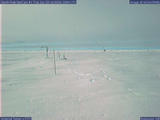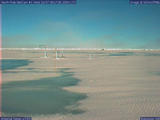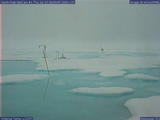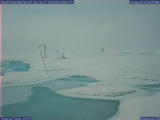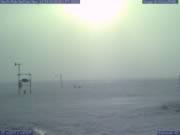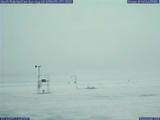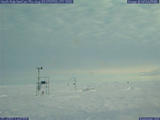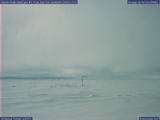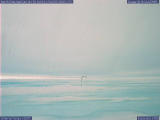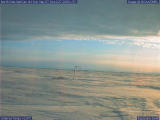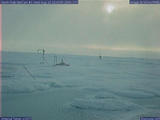Norbert
Untersteiner
Sydney Chapman Professor
University of Alaska Fairbanks
and
Professor Emeritus, Atmospheric Sciences and Geophysics
University of Washington, Seattle, WA
Background
Since 2002, the multi-agency USA-Japan joint project entitled "North Pole Environmental Observatory" (NPEO) has deployed Web Cameras along with the automatic stations and instrumentation that provide valuable air/ice/ocean datasets. Instruments included short-wave and long-wave radiometers for down-welling radiation, air temperature, wind direction and velocity, atmospheric pressure, ice temperature, and ocean temperature and salinity to 250 m depth. The Web Cam images show the installations and some scenery throughout the entire summer, from the beginning of snow melt to freeze-up in autumn and the onset of darkness.
Observations from the North Pole in summer 2004
Like the previous two summers, the summer of 2004 appeared also somewhat unusual.
Fig. 1 In 2004, the snow began to appear water-logged
in late June, significantly later than climatology |
Fig. 2 The first melt ponds appear around
July 7, 2004. |
|
Fig. 3 The total melt pond area reached a
maximum on about July 15, 2004. |
After a brief warm spell on 5 June, surface air temperatures reached the usual near-zero degrees on 12 June, perhaps a week later than climatology. Significantly later than climatology, the snow began to appear water-logged toward the end of June, but the first melt ponds do not appear until 7 July.
After that, melting seemed to progress rapidly, with ponds developing steep and even undercut margins. The webcam images suggest that total pond area reached a maximum on about 15 July. Shortly thereafter (16-17 July) several images show a thin skim of ice on the pond surfaces. This is a common occurrence in the Arctic late summer, caused by clearings of the usually overcast sky. During these, usually brief, events the increase in direct radiation from the sun is not sufficient to compensate for the loss of IR radiation from the low stratus clouds, and the result is a negative surface heat balance and the formation of a skim of ice on water that is almost at the freezing point. A striking demonstration of the inverse relationship of downwelling long and short wake radiation can be seen on 9 and 17 May when changes between overcast and clear sky caused short and long wave radiation to change in opposite direction by as much as 150 W / sq.m.
Between 20 July and 10 August, the solar radiation records shows several extremely high short-lived peaks of up to 500 W / sq.m Such high numbers are possible when the sun shines through a large opening in the sky and a great deal of additional radiation is reflected from the clouds surrounding the opening.
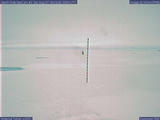 |
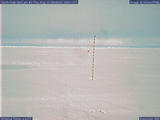 |
|
|
Fig. 5 First signs of freeze-up occur as
early as August 7, 2004. |
Fig. 6 By August 19, all ponds visible in the webcam images are covered with ice and new snow. |
The first signs of freeze-up occur as early as 7 August (Fig. 5) , and by 19 August all ponds visible in the webcam images are covered with ice and new snow (Fig 6).Sonar devices at the four buoy sites (Borneo, JAMSTEC, IABP-NORTH, IAPB-South) indicate an amount of surface melt between 15 and 35 cm. The lone ablation stake shown in the images of web cam #2 (Fig 6,7) indicates a surface mass loss of 20 cm . As in commonly observed in thick ice, bottom accretion continues through June and amounts to about 10 cm.
Comparison of Arctic summertime in 2002, 2003 and 2004
The summers of 2002, 2003, and 2004, as observed by the Web Cams, were very different (below). The onset of melting is typically in early June, but occurred in late July in 2002, and late June in 2003 and 2004. The Web Cam images show very limited melt pond coverage in 2002, but widespread melt pond coverage in 2003 and 2004. In 2003, the melt ponds were widespread by July 4, but diminished in late July, and then reformed in mid-August. This was not observed in the other years. Freezeup began in late August in 2002, Sept 7 in 2003, and in mid-August in 2004.
Summary of Arctic Summertime 2004
Despite the small number of ice thickness measurements that are available, it seems highly likely that the summer loss of ice in 2004 was anomalously small and that the 2004 melting season was unusually short.
Difficulty of Summertime Observations at the North Pole
To appreciate the value of these data and images, we should bear in mind that the proverbial "inaccessibility of the frozen Arctic Ocean" due to cold and darkness applies to the mild summer even more than to the cold and dark winter. During the long and mild days of summer melt snow and ice, the surface becomes littered with ponds and potholes, and the transportation of people and equipment is limited to the most difficult and expensive modes, i.e. helicopters and ice-breaking ships. It is for these reasons that all-year manned drifting ice stations, and hence summertime data, have been at a premium in the history of US arctic research. While the Soviet Union maintained 30 such stations between 1952 and 1991, the US scientists were able to acquire only four sets of summer data, two from the International Geophysical Year 1957 and 1958, one year from the Arctic Ice Dynamics Joint Experiment in 1975, and one year from SHEBA in 1998.
The extraordinary value of the web cam pictures is illustrated by the preceding samples. This technology is clearly producing a large amount of information at a very low cost and the current projects are only a beginning. Fish-eye lens cameras pointing to the zenith can be employed to observe cloud amount. A camera could be used to measure accumulation/ablation by taking pictures of suitably marked stakes, a method that would yield more representative values than those from a sonic device that looks at a single point. Cameras could also be used to take pictures of radiometers and other instruments to determine whether their readings are compromised by rime deposition.
More Information
What changes have occurred in Arctic sea ice volume and dynamics over the past 50 years?
North Pole Environmental Observatory
10/3/2004



